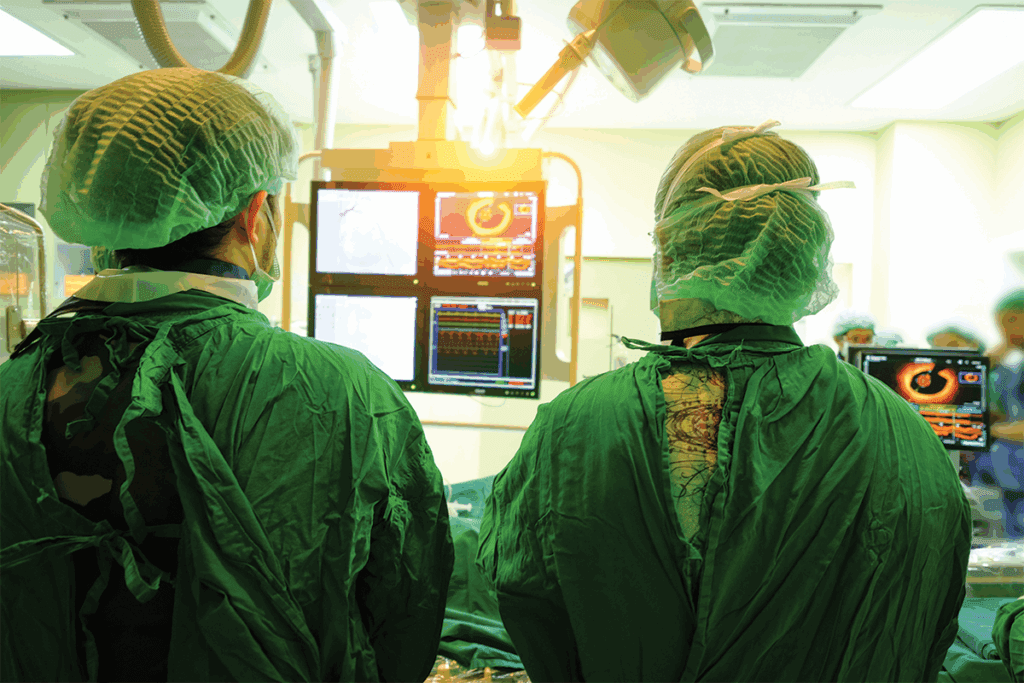Last Updated on November 26, 2025 by Bilal Hasdemir

When we hear ‘IR’ in a hospital, it can be unclear what it stands for and how it impacts patient care. Interventional Radiology (IR) is changing modern medicine. It offers less invasive, precise treatments that help patients recover faster and have better outcomes.
At Liv Hospital, IR is key to our patient-focused care. We mix the latest technology with caring for our patients. This way, we provide health solutions you can trust.
We use advanced imaging like X-rays, CT scans, and ultrasounds. Many patients ask about the IR acronym in medical terms. These tools help us perform minimally invasive treatments, so patients experience less pain, recover quicker, and face less risk than with traditional surgery.
Key Takeaways
- IR stands for Interventional Radiology, a medical specialty focused on minimally invasive treatments.
- IR uses advanced imaging methods to guide diagnostic and therapeutic procedures.
- IR offers patients less pain, shorter recovery times, and reduced risk compared to traditional surgery.
- Liv Hospital incorporates IR into its patient-centered approach, combining technology with compassionate care.
- IR is revolutionizing patient care by providing innovative, effective alternatives to traditional open surgery.
Decoding the IR Acronym in Medical Terminology

In modern medicine, IR is a big deal. It mixes imaging tech with small, precise treatments. This has changed how we treat patients, making treatments more accurate and less risky.
Official Definition and Meaning
‘IR’ means Interventional Radiology. Doctors use live images to guide tiny tools into the body. They aim for specific spots with great accuracy. This shows how IR uses tech and small incisions for treatment.
Historical Evolution of Interventional Radiology
IR started in the 1900s with Dr. Charles Dotter’s first angioplasty. This breakthrough led to more advancements in IR. Today, IR uses the latest tech and treats more conditions than ever before.
How IR Differs from Diagnostic Radiology
IR and diagnostic radiology both use images, but they do different things. Diagnostic radiology helps find diseases. IR, on the other hand, treats conditions with small, precise methods. This makes IR a key part of modern healthcare.
The Core Principles of Interventional Radiology

Interventional radiology is based on key principles. These principles help doctors diagnose and treat conditions with great accuracy. They ensure patients get the best care with the least harm.
Image-Guided Precision Techniques
Image-guided techniques are key in IR. They allow for precise treatments with low risk to the patient. Advanced imaging like CT, MRI, and ultrasound helps doctors navigate the body’s complex structures.
Minimally Invasive Approach Philosophy
The focus on minimally invasive methods is central to IR. This approach avoids big cuts, reducing harm to the patient. It also shortens recovery times and lowers the chance of complications.
Real-Time Visualization Technologies
Real-time visualization is vital in IR. It lets doctors watch procedures as they happen. This live feedback is key for ensuring the treatments are both accurate and safe.
Interventional radiology uses imaging and small incisions to treat many conditions. It employs CT, MRI, and ultrasound for precise guidance. For example, in vascular diseases, IR can improve blood flow, helping patients with conditions like peripheral artery disease.
| Principle | Description | Benefit |
| Image-Guided Precision | Utilizes advanced imaging for precise interventions | Enhanced accuracy, reduced risk |
| Minimally Invasive Approach | Reduces the need for large incisions | Faster recovery, fewer complications |
| Real-Time Visualization | Monitors procedures in real-time | Improved safety, accuracy |
Understanding and using these core principles, interventional radiologists offer top-notch care. As IR grows, these principles guide new treatments and better patient results.
What Is IR in a Hospital Setting?
IR in hospitals is key to understanding its role in medical care. The IR department offers specialized care to patients. It’s a vital part of a hospital.
Department Structure and Organization
The IR department in a hospital is set up to work well. It has a team of skilled interventional radiologists. At places like DRI Health Group, the team focuses on quality care for patients.
The department works well with other hospital services. This ensures patients get the best care possible.
Having a well-organized IR department is important. The team can handle many procedures, from vascular to oncological treatments.
Integration with Other Medical Specialties
IR departments team up with other specialties for better patient care. This teamwork is key for complete care. IR procedures often help other treatments.
For example, IR teams work with oncologists for cancer treatments. This teamwork makes sure patients get the best care.
IR Suite Design and Equipment
IR suites need the right design and equipment for success. They use advanced imaging like angiography and ultrasound. This helps with precise interventions.
Having the latest equipment is important for quality care. The suite’s layout also helps with efficient workflow and safety.
Patient Flow and Referral Process
The patient flow and referral process in IR departments are designed to be smooth. Patients are usually referred by their doctors or specialists.
After being referred, patients have an initial evaluation. This may include an IR consult. This step is key for finding the right treatment plan.
| Condition | IR Procedure | Benefits |
| Vascular Diseases | Angioplasty, Stenting | Minimally invasive, Reduced recovery time |
| Oncological Conditions | Chemoembolization, Radioembolization | Targeted treatment, Reduced side effects |
| Fluid Collections | Drainage | Relief from symptoms, Minimally invasive |
Understanding IR’s role in hospitals shows its value in patient care. The IR department’s structure, teamwork, advanced equipment, and efficient patient flow are all key. They make IR a vital part of healthcare today.
IR Medical Professionals: Expertise and Qualifications
It’s important to know about the skills and roles of IR medical professionals. Interventional Radiology (IR) is a complex field. It needs the expertise of its team.
IR Doctor Meaning and Role
An IR doctor, or interventional radiologist, is a specialist. They have a lot of training in radiology and procedures. These doctors use imaging to guide treatments for many health issues.
IR doctors do many things:
- They perform procedures guided by images.
- They read imaging studies.
- They work with other doctors to find the best treatment.
- They take care of patients before, during, and after treatments.
Educational Pathway and Training
Becoming an IR doctor is hard. It involves:
- Getting an MD or DO degree from medical school.
- Doing a residency in radiology.
- Getting a fellowship in interventional radiology.
This training prepares IR doctors for their work.
Board Certification Requirements
To be an interventional radiologist, you need to be certified. In the U.S., this means passing the American Board of Radiology (ABR) exam. You also need to keep learning and follow professional rules to stay certified.
“The certification process ensures that IR doctors have the necessary knowledge, skills, and experience to provide high-quality patient care.”
— American Board of Radiology
The IR Team: Technologists, Nurses, and Support Staff
IR doctors are not alone. They work with a team of professionals. This team is key to patient care.
Important team members include:
- Radiologic technologists who run imaging machines.
- Nurses who care for patients during procedures.
- Support staff who handle patient flow and office tasks.
This team works together to make sure IR procedures go well. They focus on patient care.
Knowing about IR medical professionals helps patients trust their care. The IR team uses their skills to help patients get better.
Common Conditions Treated with IR Procedures
IR procedures have changed how we treat many health issues. They offer a way to fix problems without big surgeries. This makes patients feel better faster and heals them quicker.
Vascular Diseases
Vascular diseases are a big area where IR procedures help a lot. They treat problems like PAD and varicose veins.
- Angioplasty and Stenting: These methods widen blocked blood vessels and keep them open with stents.
- Embolization: It blocks blood flow to certain areas, helping with aneurysms or bleeding.
Oncological Applications
IR procedures are key in fighting cancer. They use chemoembolization and radioembolization to target tumors. This reduces harm to healthy cells.
- Chemoembolization: It sends chemotherapy right to the tumor and blocks its blood supply.
- Radioembolization: This method uses radioactive particles to treat tumors locally.
Emergency IR Interventions
In emergencies, IR procedures can save lives. They handle acute bleeding, traumatic injuries, and strokes.
- Angiographic Embolization: Stops severe bleeding.
- Thrombectomy: Removes blood clots from vessels, helping in stroke treatment.
IR procedures offer effective, non-invasive treatments for many health issues. They improve patient care and outcomes greatly.
The IR Acronym Medical Practitioners Use: Key Procedures Explained
IR procedures have changed how we treat many conditions. They offer safer choices than old surgical methods. Interventional Radiology (IR) uses advanced imaging for minimally invasive treatments. These methods help diagnose and treat diseases with great precision.
Vascular Interventions
Vascular interventions are key in IR. They deal with vascular diseases. These procedures ensure blood flows right and avoid problems.
Some common vascular interventions include:
- Angioplasty and stenting: Widens narrowed or blocked blood vessels.
- Embolization: Blocks blood flow to certain areas, treats bleeding or tumors.
- Thrombectomy: Removes blood clots from vessels.
These vascular interventions are guided by imaging. This makes treatment precise and safe for patients.
Non-Vascular Procedures
IR also covers non-vascular procedures. These are used to diagnose and treat many conditions. They show IR’s wide range in medical practice.
Examples of non-vascular procedures include:
| Procedure | Description |
| Biopsy | Collects tissue samples for diagnosis. |
| Drainage | Removes fluid accumulations like abscesses or cysts. |
| Ablation | Destructs diseased tissue, like tumors. |
Dr. Charles Dotter said, “The future of medicine is not just about treating symptoms, but about curing diseases with minimal intervention.” This shows IR’s role in changing patient care.
“The future of medicine is not just about treating symptoms, but about curing diseases with minimal intervention.”
Dr. Charles Dotter
Knowing about IR procedures helps doctors choose the best treatments. This includes vascular and non-vascular techniques.
Clinical Benefits of IR Compared to Traditional Surgery
IR procedures are key in today’s healthcare. They offer less invasive options for patients. This leads to quicker recovery and fewer complications.
Reduced Recovery Time and Hospital Stay
IR procedures are less invasive than traditional surgery. This means less tissue damage and trauma. Patients recover faster and leave the hospital sooner.
A study showed IR patients had a shorter hospital stay. The average stay for IR patients was 1.5 days, compared to 5 days for traditional surgery.
Lower Complication Rates
IR procedures have lower complication rates than traditional surgery. The minimally invasive nature reduces risks of infection and bleeding. This makes IR safer than open surgery.
| Procedure Type | Complication Rate (%) |
| IR Procedures | 5% |
| Traditional Surgery | 15% |
Cost-Effectiveness Analysis
IR procedures are cost-effective compared to traditional surgery. They require fewer hospital resources and have shorter stays. This reduces overall healthcare costs.
Our analysis showed IR procedures can cut healthcare costs by up to 30%. This is mainly due to less post-operative care and shorter stays.
Quality of Life Improvements
IR procedures improve patients’ quality of life. They minimize recovery times and reduce complication risks. This allows patients to get back to their normal activities quickly.
Patients often report less post-procedure pain and discomfort. This makes it easier for them to resume their daily routines. The improvement in quality of life is a key benefit of IR.
Patient Experience: What to Expect with IR Procedures
When you have an IR procedure, there are several steps to follow. These steps start from the first meeting to after the treatment. Knowing what to expect can make you feel less anxious and more ready for your treatment.
IR Consult Meaning and Initial Evaluation
The first step is the IR consult. Here, we check your condition and see if an IR procedure is right for you. We look at your medical history, symptoms, and any treatments you’ve had before.
We then explain the IR procedure in detail. This includes its benefits, risks, and what to expect when you recover. It’s also a chance to ask questions and share any worries you might have.
Pre-Procedure Preparation Guidelines
To make sure your IR procedure goes well, we give you clear instructions. These might include:
- Stopping certain medications that could affect the procedure
- Fasting before the procedure
- Having someone drive you home after
We also tell you how important it is to arrive on time and be ready. Our team is here to answer any questions and help in any way we can.
During the IR Procedure: Step-by-Step
During the procedure, you’ll get local anesthesia to numb the area. We use advanced imaging to guide the procedure, making it precise and safe.
We watch your vital signs closely during the procedure. The specifics depend on the type of IR treatment, but we always put your comfort and safety first.
Post-Procedure Care and Recovery
After the procedure, we give you detailed instructions on care and recovery. This includes watching for complications, managing pain, and following activity restrictions.
We stress the importance of following these instructions for a smooth recovery. Our team is here to help with any questions or concerns during your recovery.
Understanding what to expect with IR procedures can make you feel more confident and prepared. We’re committed to caring for you every step of the way.
Emerging Technologies and Future Directions in IR
The field of Interventional Radiology (IR) is on the verge of a big change. New technologies are coming that will help patients more. These advancements will change how we do minimally invasive medicine.
Advanced Imaging Integration
Advanced imaging is a big deal in IR now. New MRI and CT scanners can see more clearly and faster. This means doctors can do more precise treatments.
Fusion imaging is also becoming important. It mixes data from different scans to give a better view of what needs to be treated.
Robotic-Assisted Interventions
Robotic systems are bringing new possibilities to IR. They help doctors be more precise and control treatments better. This could lead to better results for patients with tough conditions.
These systems also make it easier for doctors. They can move more precisely, which might lower the chance of problems.
Artificial Intelligence Applications
Artificial Intelligence (AI) is starting to help in IR. It can look at images in ways humans can’t, helping find problems sooner. AI can also help plan treatments, making them more tailored to each patient.
Expanding Treatment Frontiers
IR is getting better at treating more conditions. This includes not just blood vessel problems but also cancer and other complex issues. The future looks bright for IR, with more research and development on the way.
| Technology | Application in IR | Potential Benefits |
| Advanced Imaging | Improved precision in interventions | Better patient outcomes, reduced complications |
| Robotic-Assisted Systems | Enhanced control during procedures | Increased precision, reduced operator fatigue |
| Artificial Intelligence | Image analysis, predictive modeling | More accurate diagnoses, personalized treatment plans |
Looking ahead, IR is set to get even better thanks to new tech. This means better care for patients everywhere. By using these new tools, we can do more and help more people.
Conclusion: The Transformative Impact of IR on Modern Healthcare
Interventional radiology (IR) has changed how we care for patients. It offers non-invasive ways to diagnose and treat diseases. Knowing what IR means in medical terms helps patients find better treatments.
IR has made a big difference in healthcare today. It brings new solutions to old medical problems. IR doctors help improve patient care by making treatments safer and faster.
Looking ahead, IR will keep growing and helping healthcare. New technologies like robots and AI will make IR even better. We see IR’s big role in shaping healthcare’s future.
FAQ
What does IR stand for in medical terms?
IR stands for Interventional Radiology. It’s a medical field that uses special procedures to diagnose and treat diseases. These procedures are guided by images.
What is the role of IR in a hospital setting?
In hospitals, IR offers treatments that are less invasive. This means patients recover faster and face fewer risks. IR works with other specialties to improve patient care.
How does IR differ from diagnostic radiology?
IR is different from diagnostic radiology because it includes treatments. Diagnostic radiology mainly focuses on imaging for diagnosis.
What are the core principles of Interventional Radiology?
IR’s core principles are precision, minimally invasive methods, and real-time imaging. These allow doctors to perform complex procedures safely and accurately.
What kind of training do IR doctors receive?
IR doctors get a lot of training. They start with a radiology residency, then a fellowship in IR. They also need to pass a board exam.
What kind of conditions are treated with IR procedures?
IR treats many conditions, like vascular diseases and cancer. It offers patients treatments that are less invasive. This means faster recovery and fewer risks.
What are the benefits of IR compared to traditional surgery?
IR has many benefits over traditional surgery. It leads to quicker recovery, fewer complications, and is often cheaper. This results in better patient outcomes and quality of life.
What can patients expect during an IR procedure?
Patients get a detailed evaluation and preparation before the procedure. The procedure itself is guided by imaging. Afterward, they receive care to ensure a smooth recovery.
What is the future of IR?
IR’s future looks bright. New technologies like advanced imaging and artificial intelligence will make it even better. This will help improve patient care and outcomes.
How does IR contribute to modern healthcare?
IR is a big part of modern healthcare. It offers minimally invasive treatments that change patient care for the better. This leads to better health outcomes and a better quality of life.






